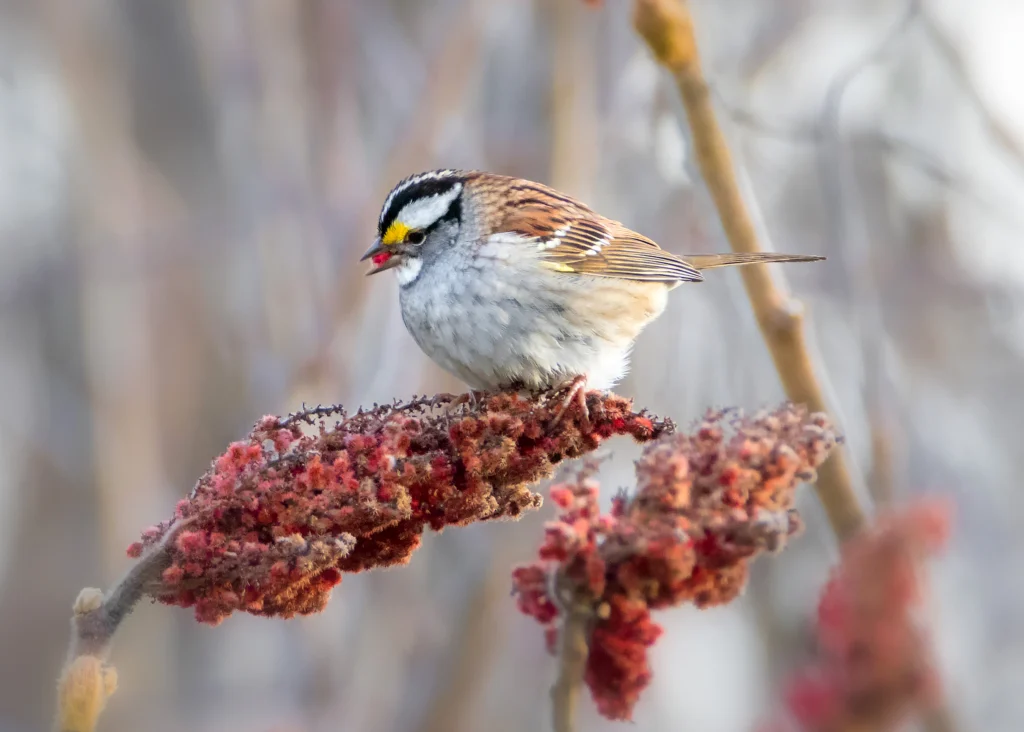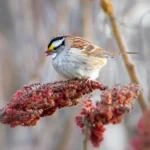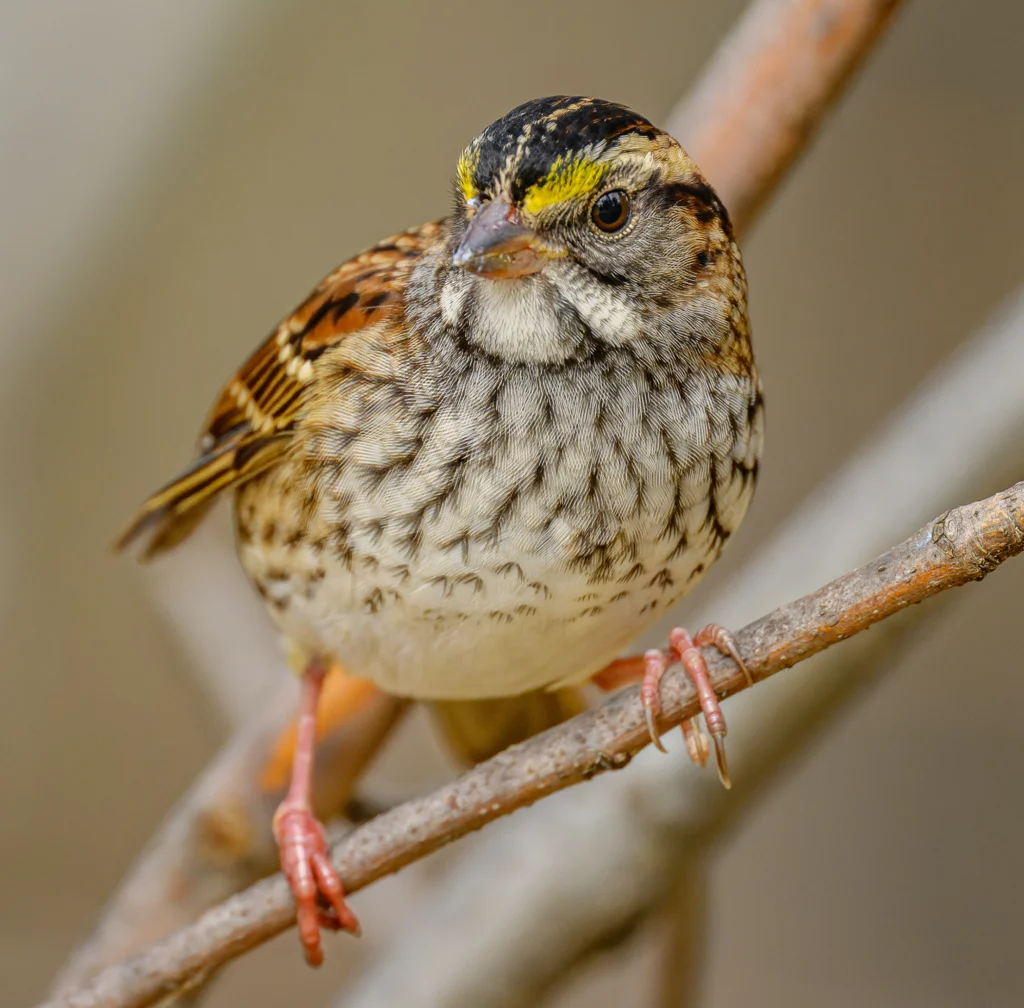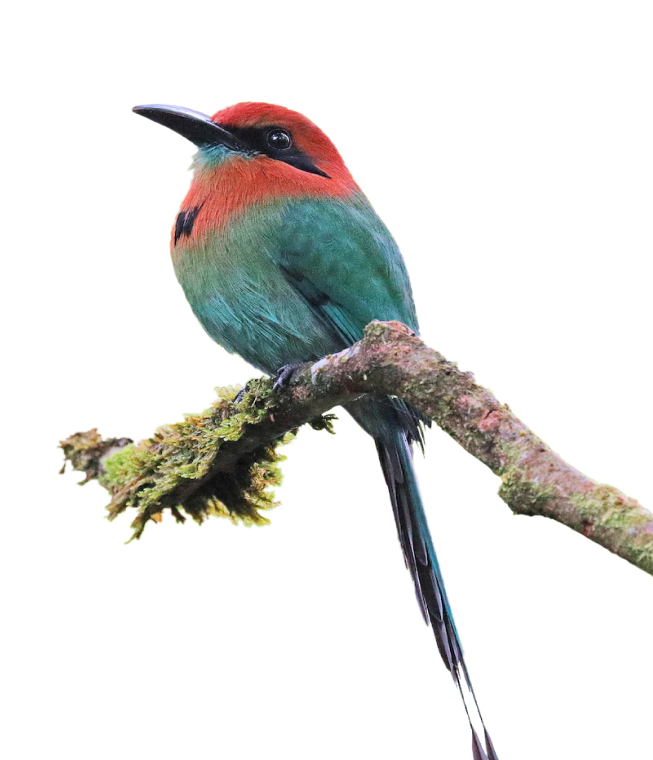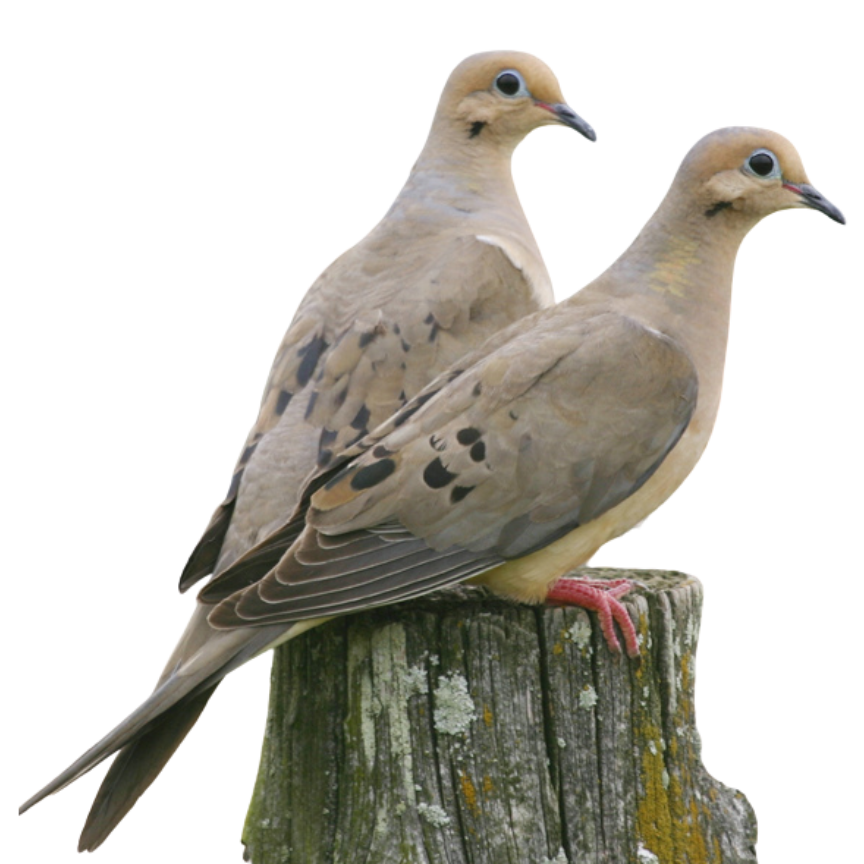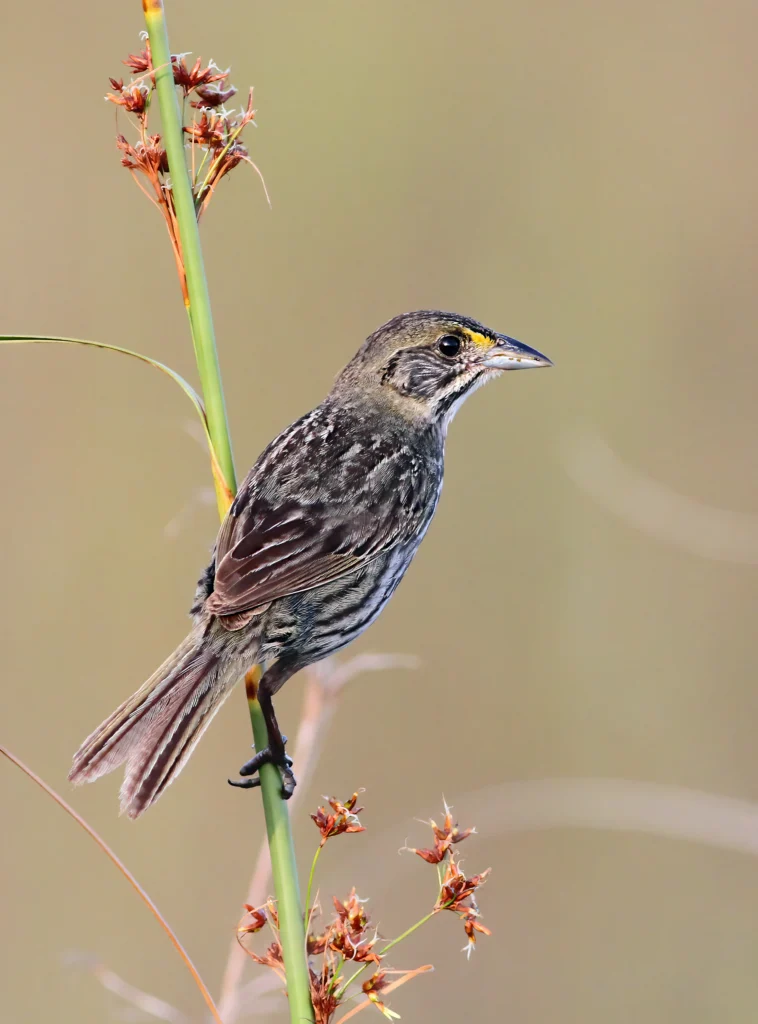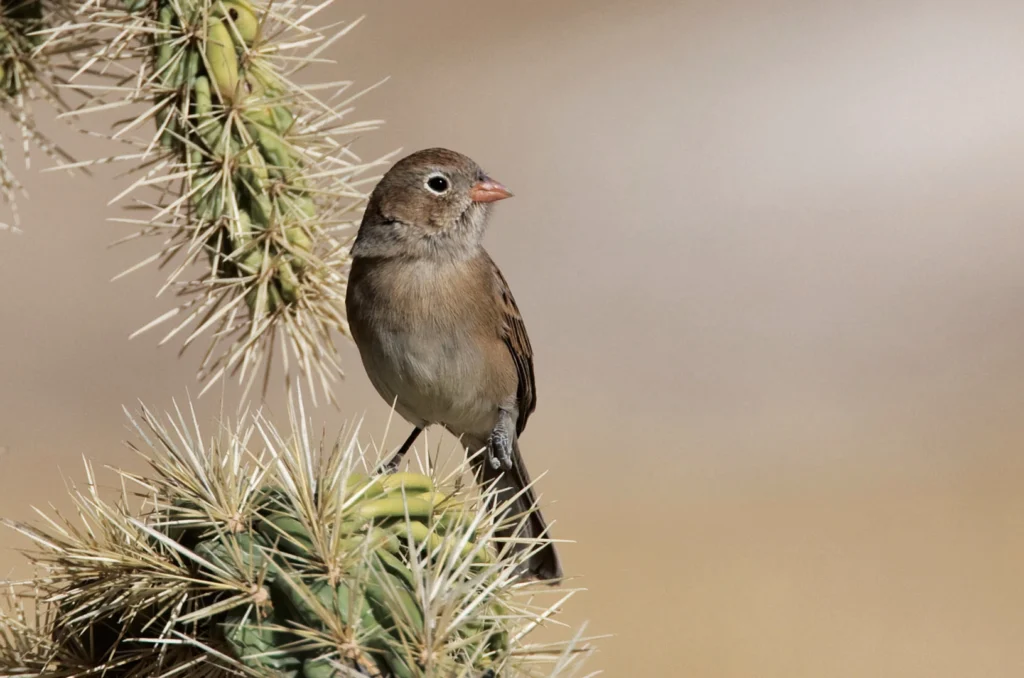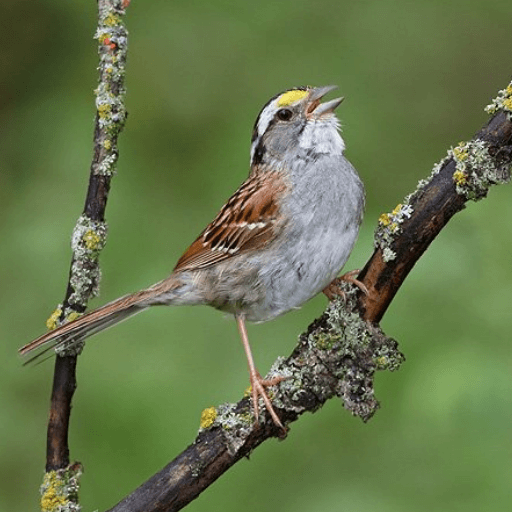
Descripción general
Acerca de
The large, stocky White-throated Sparrow is a familiar sight in backyards and around bird feeders across the eastern United States from late fall to mid-spring, and its trilling “Oh Sweet Canada” song rings out all through winter. Adults have bright yellow lores (the space between the eye and the bill), which add a touch of color to the winter landscape during its nonbreeding season. Striped crowns and whitish or white throats are other important identification features.
Amenazas
All birds, from the rarest species to familiar backyard birds such as the White-throated Sparrow, are threatened by the cumulative impacts of habitat loss, climate change, and invasive species.
Choques de vidrio
The White-throated Sparrow is one of the most frequent victims of window collisions, according to urban bird monitoring programs around the country. Because the White-throated Sparrow migrates at night, it is also vulnerable to collisions with tall, lighted structures like buildings and towers.
Pesticidas y toxinas
Widespread pesticide spraying has been shown to reduce adult White-throated Sparrow populations by direct mortality and territory abandonment. Its reproductive success is also affected by spraying, resulting in disrupted incubation, increased clutch desertion, and reduced fledging success. Pesticide exposure has also been shown to adversely affect the White-throated Sparrow’s migratory behavior.
Pérdida de hábitat
Although the White-throated Sparrow is relatively common, the conservation consortium Partners in Flight ranks it as in decline, with its population dipping an estimated 29 percent between 1970 and 2014. Loss of forest edge habitat due to agricultural development particularly affects this sparrow species.
Estrategias y proyectos de conservación
Las aves necesitan nuestra ayuda para superar las amenazas que enfrentan. En ABC, nos inspira la belleza de las aves y nos impulsa nuestra responsabilidad de encontrar soluciones para sus mayores desafíos. Con la ciencia como base, y con la inclusión y la colaboración como pilares fundamentales de todo lo que hacemos, tomamos medidas decisivas en favor de las aves en todo el continente americano.
Prevención de colisiones de vidrio
ABC’s Glass Collisions program is working to raise awareness of this pervasive problem and offer solutions that will keep even our most common birds safer, including testing and promoting bird-smart glass products and advocating for bird-friendly building standards and lighting policies.
Evite los pesticidas y las toxinas.
At ABC, we recommend against using toxic pesticides due to dangers they pose to birds and the larger environment. We also work to ensure that the Environmental Protection Agency and other agencies at the state and federal levels protect birds and people by closing regulatory loopholes, conducting more stringent testing, and canceling the registration of some of the most harmful pesticides in use.
Restaurando el hábitat
ABC’s involvement with organizations such as the North American Bird Conservation Initiative, Migratory Bird Joint Ventures, and Southern Wings allows us to advance best management practices on millions of acres of habitat in North America and beyond, benefiting breeding bird species such as the White-throated Sparrow.
Galería de aves
The White-throated Sparrow is a large, rufous-brown sparrow with a boldly patterned head, yellow lores, and a white throat. This common sparrow species is polymorphic, with two plumage types, or forms: white-striped (bright) or tan-striped (dull). On white-striped individuals, the supercilium (eyebrow) and central crown stripe are white; these areas are tan in dull individuals. White-striped birds are also much grayer on the breast, with a more clearly defined white throat; tan-striped birds have less contrasty crowns with dull black and pale brown or tan stripes, and more brown streaking on the breast. These distinct plumages are not related to age or gender, as is the case with many related bird species such as Eastern y Spotted Towhees.
Male and female White-throated Sparrows can be either bright or dull, and equal numbers of both morphs occur.

Sonidos de pájaros
Many North American birders are familiar with the distinctive and memorable song of the White-throated Sparrow: Old Sam Peabody Peabody Peabody, o Oh, Sweet Canada, Canada, Canada, but that song is evolving before our very ears. An abridged version of the repeated triplet (Peabody o Canadá) emerged west of the Canadian Rockies about two decades ago. Today, that vocal trend has spread to White-throated Sparrow populations across many parts of the continent.
The White-throated Sparrow’s sharp call note sounds similar to that of the Northern Cardinal.
Christopher McPherson, XC600075. Accessible at www.xeno-canto.org/600075.
Ray Cooke, XC566110. Accessible at www.xeno-canto.org/56611.
Martin St-Michel, XC467709. Accessible at www.xeno-canto.org/467709.
Habitats of the White-throated Sparrow
The White-throated Sparrow breeds in coniferous, deciduous, or mixed forests, particularly with dense ground cover and numerous edges. In the nonbreeding season, it uses a variety of habitats, including suburban and urban areas, as long as thick cover is present.
- In all seasons, prefers second-growth forests and forest edges, woodlots, and wooded backyards
- Found outside of the breeding season in weedy fields, borders, and hedgerows in urban and suburban areas
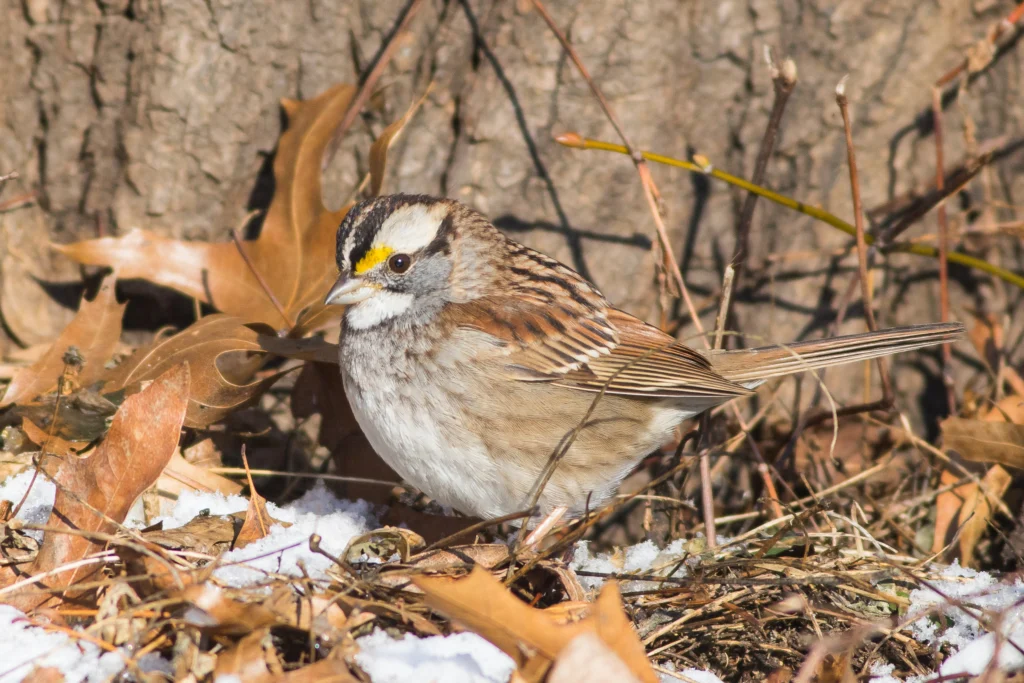
Rango y región
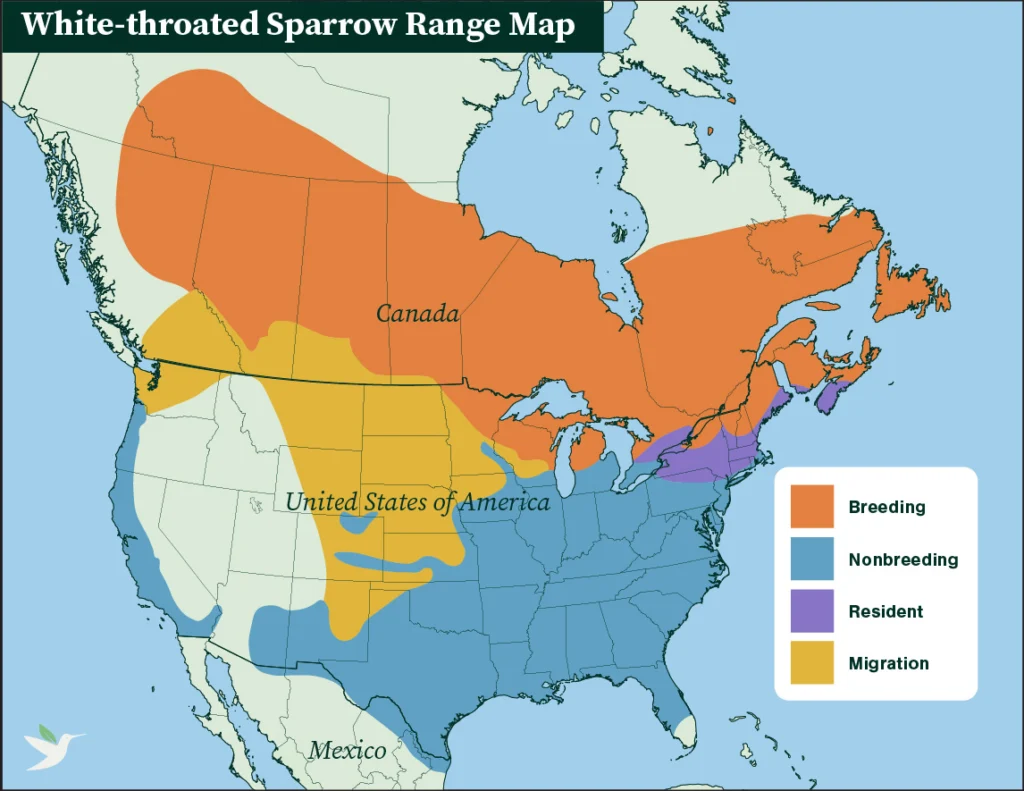
Área específica
América del norte
Detalles de la gama
This distinctive sparrow breeds in coniferous and mixed forests across much of Canada, throughout New England, and as far south as northern Pennsylvania, as well as in the northern Great Lakes region. In the nonbreeding season, it can be found from southeastern Arizona to Nova Scotia and south into central Florida, with a small population along the Pacific Coast. Some individuals show up in far northern Mexico, just south of the U.S. border. Nonbreeding populations are most dense in the Southeast, but during migration, the species regularly turns up in the Great Plains.
¿Sabías?
The White-throated Sparrow is a nocturnal migratory species. Studies have shown that females travel further south than males for the nonbreeding season.
Historia de vida
In the world of White-throated Sparrows, opposites attract! White-striped females tend to mate with tan-striped males, and vice versa. White-striped individuals, both male and female, are more aggressive than tan-striped birds, but those of the dull morph are more attentive to their offspring, so it’s a complementary pairing. Outside of the breeding season, large flocks of White-throated Sparrows can be spotted hopping around on the ground, kicking and flicking leaf litter away in search of food, and maneuvering using short flights through low, thick vegetation.
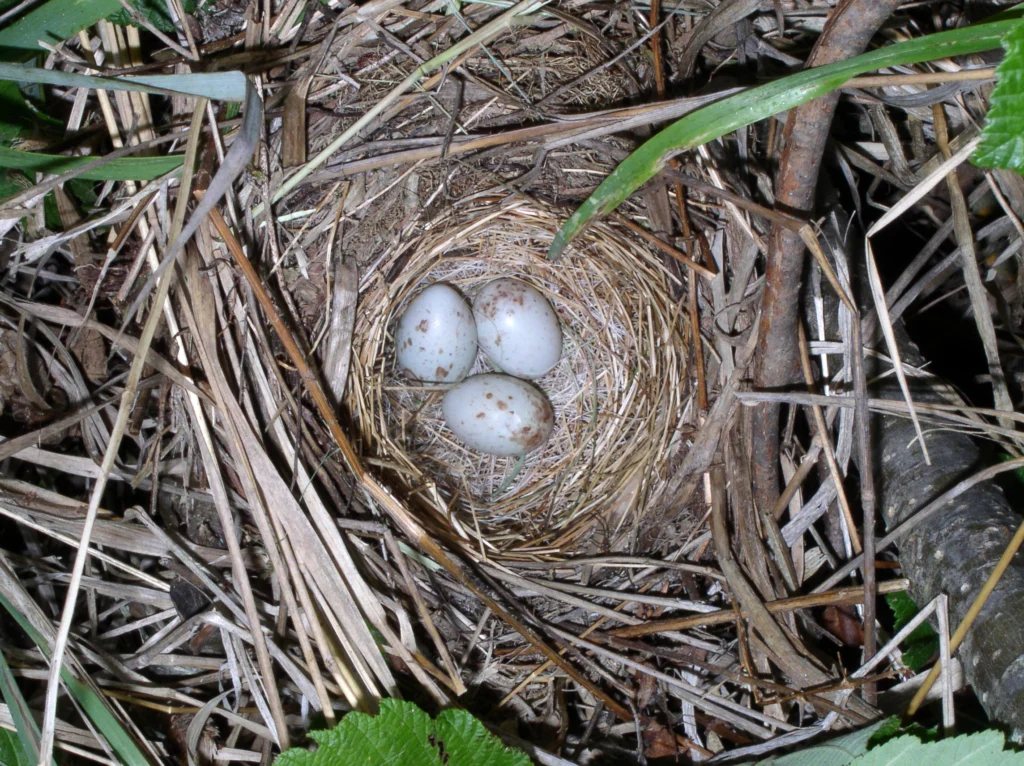
Dieta
The White-throated Sparrow eats small seeds, fruit, buds, and, when available, insects. It feeds primarily on the ground, but also in small bushes or along the lower branches of evergreen trees. On the ground, the White-throated Sparrow uses a rapid, double-footed kick to move aside leaf litter as it scratches for seeds. It can often be seen foraging alongside Song Sparrows y Dark-eyed Juncos.
At bird feeders, the White-throated Sparrow gives way to larger species such as Blue Jays, Northern Cardinals, y Eastern Towhees, but displaces smaller species such as Carolina Chickadees. Its favorite seed at feeding stations is millet, but it will eat black oil sunflower and other seeds.
Noviazgo
Socially monogamous, the White-throated Sparrow’s pair bond usually lasts through the breeding season, but not necessarily between years. Male White-throated Sparrows return to their breeding range to establish nesting territories one or two weeks before females arrive. Pairs form quickly, and the male and female frequently forage together.
Anidación
The female White-throated Sparrow builds her open, cup-shaped nest alone, siting it on or near the ground and hidden by vegetation, usually along a thicket edge. Nesting materials include grasses, twigs, pine needles, wood chips, and deer fur.
Huevos y crías
On average, a female lays four pale-blue or greenish-blue eggs that are speckled with purple or chestnut. She incubates her eggs for around 12 days. Both parents feed the young birds, which leave the nest seven to 12 days after hatching. After fledging, these “youngsters” still depend on their parents for an additional two weeks or so.
White-throated Sparrows occasionally mate with Dark-eyed Juncos, with the resulting offspring resembling extra-gray White-throated Sparrows. A hybrid’s song combines the trill of a junco with the triplet notes of a White-throated Sparrow.

